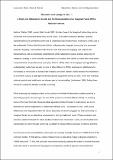‘Oh motherland I pledge to thee…’ : a study into nationalism, gender and the representation of an imagined family within national anthems
Date
04/2015Metadata
Show full item recordAbstract
In this paper we aim to join feminist critiques of nationalism, arguing that beyond understanding nations as imagined communities (Anderson 1983: 6), the symbolic construction of gender must also be considered in the formation of those communities. We argue that the metaphor of an ‘imagined family’ or ‘filial community’ is a more useful concept towards understanding the links between gender and nationhood in four ways as family relations: 1) provide a clear, hierarchical structure, 2) prescribe social roles and responsibilities, 3) are linked to positive affective connotations and 4) reify social phenomena as biologically determined. In order to empirically substantiate our claim, we will explore the prevalence and use of family metaphors in a key symbol of nationhood discourses of nationhood. Through a qualitative analysis of national anthems as ‘mnemonics of national identity’, we demonstrate the widespread presence of family metaphors, discussing how they reproduce ideas of family and gender. Finally, we discuss how the ‘imagined family’ as present in anthems and other forms of national representation could inform future studies of nationalism and national politics.
Citation
Lauenstein , O , Murer , J S , Boos , M & Reicher , S D 2015 , ' ‘Oh motherland I pledge to thee…’ : a study into nationalism, gender and the representation of an imagined family within national anthems ' , Nations and Nationalism , vol. 21 , no. 2 , pp. 309-329 . https://doi.org/10.1111/nana.12123
Publication
Nations and Nationalism
Status
Peer reviewed
ISSN
1354-5078Type
Journal article
Collections
Items in the St Andrews Research Repository are protected by copyright, with all rights reserved, unless otherwise indicated.

